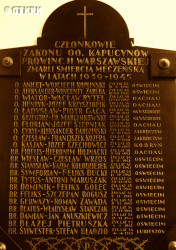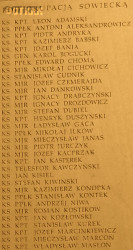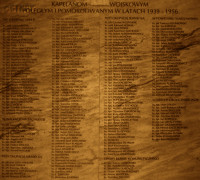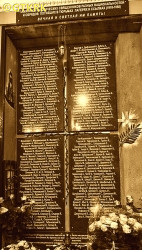Roman Catholic
St Sigismund parish
05-507 Słomczyn
85 Wiślana Str.
Konstancin deanery
Warsaw archdiocese, Poland
full list:
displayClick to display full list

searchClick to search full list by categories
wyświetlKliknij by wyświetlić pełną listę po polsku

szukajKliknij by przeszukać listę wg kategorii po polsku

Martyrology of the clergy — Poland
XX century (1914 – 1989)
personal data

surname
GACA
forename(s)
Peter (pl. Piotr)
religious forename(s)
Ladislav (pl. Ładysław)
religious forename(s)
versions/aliases
Vladislav (pl. Władysław)
function
religious cleric
creed
Latin (Roman Catholic) Church RCmore on
en.wikipedia.org
[access: 2014.09.21]
congregation
Order of Capuchin Friars Minor OFMCapmore on
en.wikipedia.org
[access: 2013.05.19]
(i.e. Capuchins)
diocese / province
Warsaw province OFMcapmore on
www.kapucyni.pl
[access: 2014.08.18]
RC Military Ordinariate of Polandmore on
en.wikipedia.org
[access: 2014.12.20]
date and place
of death
04.10.1942

ITL KarLagGuLAG slave labour camp network
today: n. Karaganda, Karaganda reg., Kazakhstan
more on
en.wikipedia.org
[access: 2019.10.13]
alt. dates and places
of death
06.1941
details of death
After German and Russian invasion of Poland in 09.1939 and start of the World War II took care of Polish soldiers wounded in 09.1939 defense campaign.
After Germans handed over Łomża to their Russian ally on 26‐29.09.1939, in accordance with Ribbentrop–Molotov accord, took part in emerging Polish clandestine resistance efforts — first as Service for Poland's Victory SZP and next as Armed Struggle Union ZWZ (part of emerging Polish Clandestine State).
Arrested by the Russians on 23.05.1940 in Łomża, during mass arrests of Polish resistance fighters, prob. together with Fr Francis Marcinkowski.
Jailed in Łomża prison.
In 1941 — prob. right before German attack in 06.1941 of their erstwhile ally, Russians — moved to Minsk prison and from there transported to ITL KarLag slave labour camp — Gulag — where in all probability je perished in unknown circumstances.
alt. details of death
According to some sources perished in one of the „death marches” after German attack in 06.1941 of their erstwhile ally, Russians — prob. while rushed by Russians toward Minsk.
cause of death
extermination
perpetrators
Russians
sites and events
ITL KarLagClick to display the description, GulagClick to display the description, MinskClick to display the description, 06.1941 massacres (NKVD)Click to display the description, ŁomżaClick to display the description, Ribbentrop‐MolotovClick to display the description, Pius XI's encyclicalsClick to display the description
date and place
of birth
28.02.1907Birth certification on:
metryki.genealodzy.pl
[access: 2025.04.13]

Kozieniectoday: Potworów gm., Przysucha pov., Masovia voiv., Poland
more on
en.wikipedia.org
[access: 2022.01.28]
parents
GACA John
🞲 ?, ? — 🕆 ?, ?

MURAWSKA Marianne
🞲 ?, ? — 🕆 ?, ?
baptism
28.02.1907Birth certification on:
metryki.genealodzy.pl
[access: 2025.04.13]

Potworówtoday: Potworów gm., Przysucha pov., Masovia voiv., Poland
more on
en.wikipedia.org
[access: 2021.09.29]
St Dorothy Virgin and Martyr RC church
presbyter (holy orders)
ordination
25.07.1933

Nantestoday: Loire‐Atlantique dep., Pays de la Loire reg., France
more on
en.wikipedia.org
[access: 2023.11.24]
positions held
c. 1939 – 1940
guardian — Łomżatoday: Łomża city pov., Podlaskie voiv., Poland
more on
en.wikipedia.org
[access: 2022.01.28] ⋄ Blessed Virgin Mary of Sorrows monastery, Capuchins OFMCap
c. 1939
teacher — Łomżatoday: Łomża city pov., Podlaskie voiv., Poland
more on
en.wikipedia.org
[access: 2022.01.28] ⋄ St Fidelis of Sigmaringen College, Capuchins OFMCap
till 1933
student — Tourstoday: Tours arr., Indre‐et‐Loire dep., Centre‐Val de Loire reg., France
more on
en.wikipedia.org
[access: 2022.11.12] — lecturer in philosophy and theology
student — EijsdenBreust neighborhood
today: Eijsden‐Margraten, Niederlands
more on
en.wikipedia.org
[access: 2022.11.12] ⋄ Philosophical Study (higher theological seminary), monastery, Capuchins OFMCap
1925
accession — Capuchins OFMCap
others related
in death
MARCINKOWSKIClick to display biography Francis (Fr Gregory)
sites and events
descriptions
ITL KarLag: Russian Rus. Исправи́тельно‐Трудово́й Ла́герь (Eng. Corrective Labor Camp) ITL Rus. Карагандинский (Eng. Karagandskiy) — concentration and slave forced labor camp (within the Gulag complex) — with headquarters in the city of Karaganda, Karaganda Oblast in Kazakhstan. Founded on 17.09.1931. One of the largest in the Gulag complex. It covered an area of 300 by 200 km, with its center in the Dolynka village, c. 45 km from Karaganda. One of the tasks was to grow food, especially animal husbandry, for the emerging centers of coal mining and heavy industry in Kazakhstan. Prisoners slaved in camp workshops (metal processing, drawing, tailoring), in the production of construction materials, in a glassworks, a sugar refinery, a vegetable drying plant, in coal mines, limestone mining, and in fishing. At its peak, c. 65,000 prisoners were held there: e.g. 45,798 (01.01.1943); 50,080 (01.01.1944); 53,946 (01.01.1945); 60,745 (01.01.1947); 63,555 (01.01.1948); 65,673 (01.01.1949); 54,179 (01.01.1950); 45,675 (01.01.1951). In total, c. 1,000,000 people passed through the camp, including many women and children. Many died. It ceased operations on 27.07.1959. (more on: en.wikipedia.orgClick to attempt to display webpage
[access: 2019.10.13])
Gulag: The acronym Gulag comes from the Rus. Главное управление исправительно‐трудовых лагерей и колоний (Eng. Main Board of Correctional Labor Camps). The network of Russian concentration camps for slave labor was formally established by the decision of the highest Russian authorities on 27.06.1929. Control was taken over by the OGPU, the predecessor of the genocidal NKVD (from 1934) and the MGB (from 1946). Individual gulags (camps) were often established in remote, sparsely populated areas, where industrial or transport facilities important for the Russian state were built. They were modeled on the first „great construction of communism”, the White Sea‐Baltic Canal (1931‐1932), and Naftali Frenkel, of Jewish origin, is considered the creator of the system of using forced slave labor within the Gulag. He went down in history as the author of the principle „We have to squeeze everything out of the prisoner in the first three months — then nothing is there for us”. He was to be the creator, according to Alexander Solzhenitsyn, of the so‐called „Boiler system”, i.e. the dependence of food rations on working out a certain percentage of the norm. The term ZEK — prisoner — i.e. Rus. заключенный‐каналоармец (Eng. canal soldier) — was coined in the ITL BelBaltLag managed by him, and was adopted to mean a prisoner in Russian slave labor camps. Up to 12 mln prisoners were held in Gulag camps at one time, i.e. c. 5% of Russia's population. In his book „The Gulag Archipelago”, Solzhenitsyn estimated that c. 60 mln people were killed in the Gulag until 1956. Formally dissolved on 20.01.1960. (more on: en.wikipedia.orgClick to attempt to display webpage
[access: 2024.04.08])
Minsk: Russian prison. In 1937 site of mass murders perpetrated by the Russians during a „Great Purge”. After Russian invasion of Poland in 09.1939 and start of the World War II place of incarceration of many Poles, In 06.1941, under attack by Germans, Russians murdered there a group of Polish prisoner kept in Central and co‐called American prisons in Mińsk. The rest were driven towards Chervyen in a „death march” (10,000‐20,000 prisoners perished), into Russia. (more on: pl.wikipedia.orgClick to attempt to display webpage
[access: 2013.08.17])
06.1941 massacres (NKVD): After German attack of Russian‐occupied Polish territory and following that of Russia itself, before a panic escape, Russians murdered — in accordance with the genocidal order issued on 24.06.1941 by the Russian interior minister Lawrence Beria to murder all prisoners (formally „sentenced” for „counter‐revolutionary activities”, „anti‐Russian acts”, sabotage and diversion, and political prisoners „in custody”), held in NKVD‐run prisons in Russian occupied Poland, Lithuania, Latvia and Estonia — c. 40,000‐50,000 prisoners. In addition Russians murdered many thousands of victims arrested after German attack regarding them as „enemies of people” — those victims were not even entered into prisons’ registers. Most of them were murdered in massacres in the prisons themselves, the others during so‐called „death marches” when the prisoners were driven out east. After Russians departure and start of German occupation a number of spontaneous pogroms of Jews took place. Many Jews collaborated with Russians and were regarded as co‐responsible for prison massacres. (more on: en.wikipedia.orgClick to attempt to display webpage
[access: 2021.12.19])
Łomża: During German occupation penal prison run by the Germans, where hundreds of Polish political prisoners were held captive. After Russian arrival prison run by Polish UB, a unit of murderous Russian NKVD. (more on: www.slady.ipn.gov.plClick to attempt to display webpage
[access: 2014.09.21], www.sztetl.org.plClick to attempt to display webpage
[access: 2014.09.21])
Ribbentrop‐Molotov: Genocidal Russian‐German alliance pact between Russian leader Joseph Stalin and German leader Adolf Hitler signed on 23.08.1939 in Moscow by respective foreign ministers, Mr. Vyacheslav Molotov for Russia and Joachim von Ribbentrop for Germany. The pact sanctioned and was the direct cause of joint Russian and German invasion of Poland and the outbreak of the World War II in 09.1939. In a political sense, the pact was an attempt to restore the status quo ante before 1914, with one exception, namely the „commercial” exchange of the so‐called „Kingdom of Poland”, which in 1914 was part of the Russian Empire, fore Eastern Galicia (today's western Ukraine), in 1914 belonging to the Austro‐Hungarian Empire. Galicia, including Lviv, was to be taken over by the Russians, the „Kingdom of Poland” — under the name of the General Governorate — Germany. The resultant „war was one of the greatest calamities and dramas of humanity in history, for two atheistic and anti‐Christian ideologies — national and international socialism — rejected God and His fifth Decalogue commandment: Thou shall not kill!” (Abp Stanislav Gądecki, 01.09.2019). The decisions taken — backed up by the betrayal of the formal allies of Poland, France and Germany, which on 12.09.1939, at a joint conference in Abbeville, decided not to provide aid to attacked Poland and not to take military action against Germany (a clear breach of treaty obligations with Poland) — were on 28.09.1939 slightly altered and made more precise when a treaty on „German‐Russian boundaries and friendship” was agreed by the same murderous signatories. One of its findings was establishment of spheres of influence in Central and Eastern Europe and in consequence IV partition of Poland. In one of its secret annexes agreed, that: „the Signatories will not tolerate on its respective territories any Polish propaganda that affects the territory of the other Side. On their respective territories they will suppress all such propaganda and inform each other of the measures taken to accomplish it”. The agreements resulted in a series of meeting between two genocidal organization representing both sides — German Gestapo and Russian NKVD when coordination of efforts to exterminate Polish intelligentsia and Polish leading classes (in Germany called «Intelligenzaktion», in Russia took the form of Katyń massacres) where discussed. Resulted in deaths of hundreds of thousands of Polish intelligentsia, including thousands of priests presented here, and tens of millions of ordinary people,. The results of this Russian‐German pact lasted till 1989 and are still in evidence even today. (more on: en.wikipedia.orgClick to attempt to display webpage
[access: 2015.09.30])
Pius XI's encyclicals: Facing the creation of two totalitarian systems in Europe, which seemed to compete with each other, though there were more similarities than contradictions between them, Pope Pius XI issued in 03.1937 (within 5 days) two encyclicals. In the „Mit brennender Sorge” (Eng. „With Burning Concern”) published on 14.03.1938, condemned the national socialism prevailing in Germany. The Pope wrote: „Whoever, following the old Germanic‐pre‐Christian beliefs, puts various impersonal fate in the place of a personal God, denies the wisdom of God and Providence […], whoever exalts earthly values: race or nation, or state, or state system, representatives of state power or other fundamental values of human society, […] and makes them the highest standard of all values, including religious ones, and idolizes them, this one […] is far from true faith in God and from a worldview corresponding to such faith”. On 19.03.1937, published „Divini Redemptoris” (Eng. „Divine Redeemer”), in which criticized Russian communism, dialectical materialism and the class struggle theory. The Pope wrote: „Communism deprives man of freedom, and therefore the spiritual basis of all life norms. It deprives the human person of all his dignity and any moral support with which he could resist the onslaught of blind passions […] This is the new gospel that Bolshevik and godless communism preaches as a message of salvation and redemption of humanity”… Pius XI demanded that the established human law be subjected to the natural law of God , recommended the implementation of the ideal of a Christian state and society, and called on Catholics to resist. Two years later, National Socialist Germany and Communist Russia came together and started World War II. (more on: www.vatican.vaClick to attempt to display webpage
[access: 2023.05.28], www.vatican.vaClick to attempt to display webpage
[access: 2023.05.28])
sources
personal:
www.powolanie-kapucyni.plClick to attempt to display webpage
[access: 2014.05.09], biographies.library.nd.eduClick to attempt to display webpage
[access: 2014.05.09], metryki.genealodzy.plClick to attempt to display webpage
[access: 2025.04.13], ru.openlist.wikiClick to attempt to display webpage
[access: 2019.02.02]
bibliographical:
„Lexicon of Polish clergy repressed in USSR in 1939‐1988”, Roman Dzwonkowski, SAC, ed. Science Society KUL, 2003, Lublin
original images:
www.katedrapolowa.plClick to attempt to display webpage
[access: 2014.01.16], ipn.gov.plClick to attempt to display webpage
[access: 2019.02.02]
LETTER to CUSTODIAN/ADMINISTRATOR
If you have an Email client on your communicator/computer — such as Mozilla Thunderbird, Windows Mail or Microsoft Outlook, described at WikipediaPatrz:
en.wikipedia.org, among others — try the link below, please:
LETTER to CUSTODIAN/ADMINISTRATORClick and try to call your own Email client
If however you do not run such a client or the above link is not active please send an email to the Custodian/Administrator using your account — in your customary email/correspondence engine — at the following address:

giving the following as the subject:
MARTYROLOGY: GACA Peter
To return to the biography press below:
 Click to return to biography
Click to return to biography











